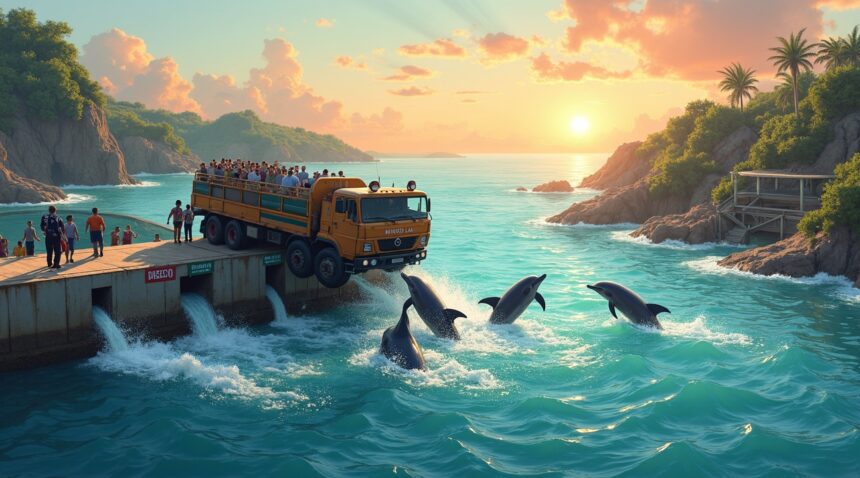Mexico’s Senate unanimously passed groundbreaking legislation in June 2025 that completely bans marine mammal entertainment and mandates the release of approximately 350 captive dolphins currently held in facilities across the country.
This comprehensive law, known as the Mincho Law after an injured dolphin whose suffering sparked national outrage, represents one of the most significant animal welfare victories in Latin American history and positions Mexico as a global leader in marine conservation.
Key Takeaways
- Complete ban on marine mammal entertainment: The law prohibits all commercial dolphin shows, swim-with-dolphin programs, and therapeutic sessions. It also ends future captures of wild dolphins and restricts breeding programs exclusively to legitimate conservation purposes.
- 350 dolphins will be relocated: Most of Mexico’s captive dolphins — including 250 in Quintana Roo — must be transferred from concrete tanks to more suitable sea pens or marine sanctuaries with natural seawater access.
- The Mincho incident catalyzed change: A viral video of an injured dolphin at a Barceló Hotel facility, combined with evidence of over 300 exploited dolphins over the years, fueled intense public pressure that led to legislative reform.
- Scientific evidence supports the ban: Back in 2022, more than 100 scientists denounced dolphin captivity, citing studies that revealed dolphins suffer from chronic stress, mental trauma, and reduced lifespans when confined to artificial settings.
- Tourism industry faces major restructuring: The Dolphin Company filed for bankruptcy after the ban’s enactment. However, the legislation includes worker protection policies and potentially sets a precedent for similar reforms in other global tourist hubs.
The passage of the Mincho Law is a landmark moment for marine animal rights. Organizations like World Animal Protection have long advocated for such changes, and Mexico’s decision may pave the way for broader reform worldwide.
Historic Senate Vote Bans All Marine Mammal Entertainment in Mexico
June 26, 2025 marked a pivotal moment in animal welfare history when Mexico’s Senate and Chamber of Deputies unanimously passed groundbreaking legislation that prohibits the use of dolphins and other marine mammals in commercial entertainment. I witnessed a historic shift in how Mexico approaches marine mammal protection, with this comprehensive law setting a new standard for animal rights across Latin America.
The legislation targets multiple facets of marine mammal exploitation, creating a complete ban on dolphin shows, swim-with-dolphin programs, and therapeutic sessions that use these intelligent creatures for profit. Mexico’s lawmakers recognized that these activities, while popular with tourists, cause significant stress and harm to marine mammals forced into unnatural environments and behaviors.
Comprehensive Ban Covers All Commercial Activities
The new law extends far beyond simple performance bans, addressing the entire ecosystem of marine mammal exploitation. Future captures of wild dolphins are now completely prohibited, ending the practice of removing these animals from their natural habitats for commercial purposes. Breeding programs face strict limitations, with exceptions granted only for legitimate conservation efforts that demonstrate clear scientific merit and species preservation goals.
Commercial tourism operations can no longer offer interactive experiences with captive marine mammals, effectively ending a lucrative industry that has operated in Mexican coastal resorts for decades. This includes popular activities like:
- Swimming with dolphins
- Photo opportunities
- Therapeutic programs that lack scientific backing
The legislation makes clear distinctions between authentic conservation work and commercial ventures disguised as educational or therapeutic programs.
Amendment Protects Wildlife While Supporting Science
The unanimous Senate vote demonstrates remarkable political consensus around animal welfare reform, with legislators from across party lines supporting the measure. This rare unity reflects growing public awareness about marine mammal intelligence and the ethical concerns surrounding their captivity for entertainment purposes.
By amending the General Law of Wildlife, Mexico ensures that exceptions remain narrowly defined and scientifically justified. Legitimate research institutions and conservation organizations can still work with marine mammals, but they must demonstrate clear scientific objectives that benefit species preservation rather than commercial gain. This approach mirrors similar conservation efforts seen in other regions where marine wildlife protection has become a priority.
The law creates a framework for evaluating proposed research and conservation programs, requiring detailed justification for any interaction with marine mammals. Organizations must prove their activities contribute meaningfully to scientific understanding or species conservation, preventing commercial operators from exploiting these exceptions.
Mexico’s decision represents a significant victory for animal rights advocates who have long argued that marine mammals suffer psychological and physical harm in captivity. The legislation acknowledges scientific evidence showing that dolphins and whales are highly intelligent, social creatures that cannot thrive in artificial environments designed for human entertainment.
The financial impact on Mexico’s tourism industry remains to be seen, as many coastal resorts have relied on marine mammal attractions to draw visitors. However, the unanimous legislative support suggests that lawmakers prioritize animal welfare over tourism revenue, potentially encouraging the development of wildlife observation tours and other eco-friendly alternatives.
International animal welfare organizations have praised Mexico’s bold action, viewing it as a model for other countries still permitting marine mammal entertainment. The comprehensive nature of the ban, combined with its strong legal foundation, makes it difficult for commercial operators to find loopholes or continue harmful practices under different labels.
Mexico joins a growing number of countries recognizing that marine mammals belong in their natural habitats, not in concrete pools performing tricks for human entertainment. The law’s emphasis on authentic conservation work ensures that legitimate scientific research can continue while ending the exploitation of these remarkable creatures for profit.
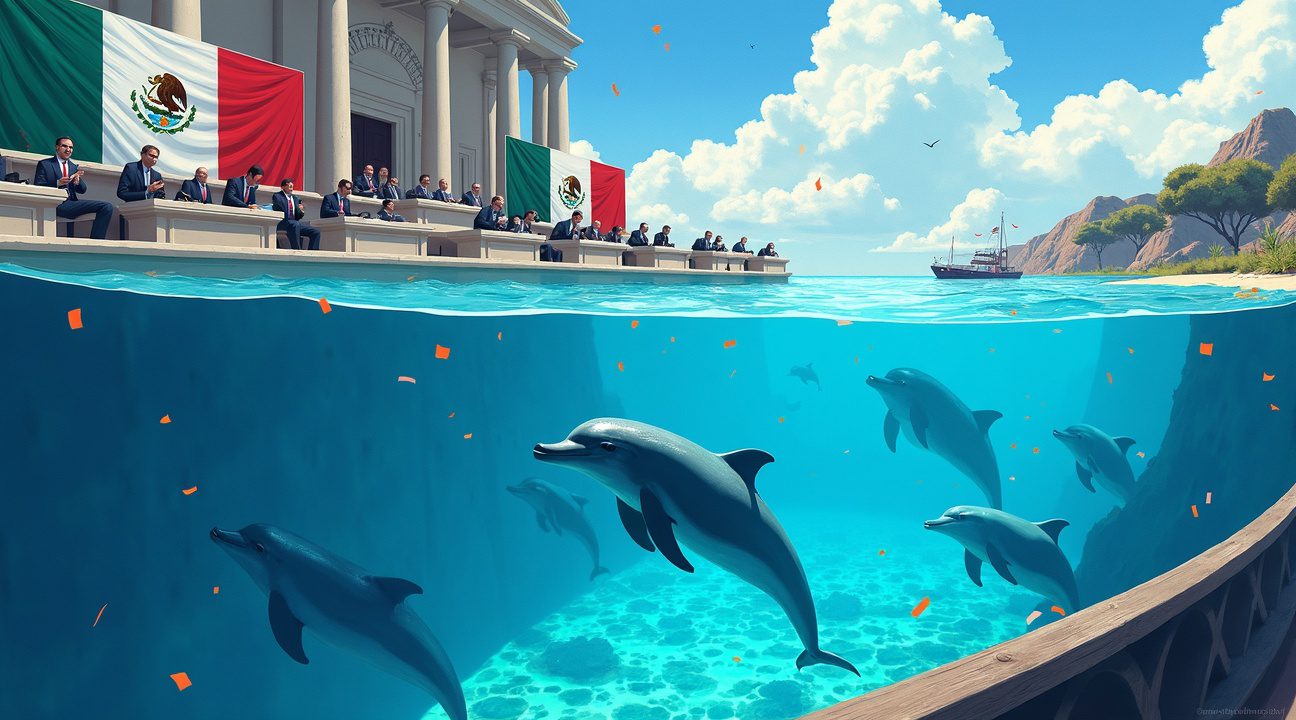
350 Dolphins Face Freedom After Years in Concrete Tanks
Mexico’s groundbreaking legislation affects approximately 350 dolphins currently held in captivity across the country, with the majority concentrated in tourist destinations that have built their entertainment industries around marine mammal shows. The state of Quintana Roo alone houses at least 250 of these dolphins, representing the largest concentration of captive marine mammals in the nation. This significant number places Mexico among the countries with substantial captive dolphin populations, accounting for about 8% of all captive dolphins worldwide.
The dolphins currently confined in concrete tanks face a dramatic transition as the new law mandates their relocation to more natural environments. These marine mammals, many of whom have spent years or even their entire lives in artificial enclosures, must now be moved to sea pens or marine enclosures that provide flowing seawater and opportunities for more natural social behaviors. This shift represents a fundamental change from the sterile, chlorinated environments they’ve known to settings that more closely mimic their ocean homes.
Assessment and Relocation Process
Each dolphin will undergo individual assessment to determine their suitability for release or transfer to specialized sanctuaries. Years of confinement have created unique challenges that marine biologists and veterinarians must carefully evaluate before making placement decisions. The assessment process considers several critical factors:
- Physical health conditions resulting from prolonged captivity
- Behavioral adaptations that may affect survival in natural environments
- Social skills and ability to integrate with wild dolphin populations
- Age and overall fitness levels for potential ocean release
- Psychological trauma or dependency issues developed in captivity
Federal oversight will guide the implementation process, ensuring that each dolphin receives appropriate care during the transition period. Marine protection zones, including the Bay of Campeche, have been identified as potential release sites for dolphins deemed suitable for return to the wild. These areas offer protected waters where released dolphins can readjust to ocean life while remaining within monitored environments.
The logistical challenges of relocating 350 dolphins cannot be understated. Transportation alone requires specialized equipment and expertise to ensure the animals’ safety during what may be their first journey beyond facility walls in years. Veterinary teams must accompany each transfer, monitoring stress levels and vital signs throughout the relocation process.
Some dolphins may never return to the open ocean due to health complications or behavioral issues stemming from their captivity. These animals will find new homes in accredited sanctuaries that provide larger, more natural environments while continuing to offer necessary medical care. Sanctuary facilities typically feature sea pens with direct ocean access, allowing dolphins to experience tides, natural currents, and marine life while remaining under human care.
The timeline for this massive relocation effort depends on various factors, including the availability of suitable facilities, weather conditions for transport, and the individual readiness of each dolphin. Marine biologists expect the process to unfold over several months or potentially years, as rushing the transition could prove harmful to animals already stressed by years of confinement.
Mexico’s approach sets a precedent for other nations grappling with similar ethical questions about marine mammal captivity. The return of marine mammals to their natural habitats represents a growing global movement toward recognizing these intelligent creatures’ rights to live in environments that support their physical and psychological well-being.
The success of this initiative will largely depend on the coordination between federal agencies, marine sanctuaries, and conservation organizations. Each dolphin’s journey from concrete tank to ocean freedom represents both a personal victory and a broader statement about humanity’s evolving relationship with marine life.
The Mincho Law: How One Injured Dolphin Changed Everything
The transformation of Mexico’s marine mammal protection laws began with a single, heartbreaking incident that would reverberate through the country’s legislative halls. A dolphin named Mincho suffered severe injuries during a tourist show at Barceló Hotel’s dolphinarium, creating a viral video that exposed the harsh realities behind these entertainment venues. This incident didn’t occur in isolation—it represented the tipping point in a growing movement against marine mammal exploitation.
From Tragedy to Legislative Action
I’ve observed how public opinion can shift dramatically when confronted with undeniable evidence of animal suffering. The Mincho case exemplified this phenomenon perfectly. The injured dolphin’s plight sparked immediate outrage across social media platforms, forcing Mexican lawmakers to confront an issue they’d previously overlooked. Additional incidents at the same Barceló facility further intensified the pressure, creating an unstoppable wave of public demand for change.
The Mexican government faced mounting pressure from multiple directions. Organizations like Animal Heroes and World Animal Protection leveraged their expertise and advocacy networks to maintain momentum behind the legislative push. These groups understood that lasting change required more than emotional appeals—they needed comprehensive documentation and sustained political engagement to transform public outrage into concrete policy reform.
Documenting Decades of Exploitation
The campaign “The Suffering Behind the Smile” provided the factual foundation necessary for meaningful legislative action. This initiative documented the exploitation of over 300 dolphins in Mexican facilities across several decades, revealing patterns of abuse that extended far beyond isolated incidents. The campaign’s findings painted a disturbing picture of systematic mistreatment disguised as family entertainment.
I find it significant that the movement’s success stemmed from this combination of emotional catalyst and methodical documentation. The Mincho incident provided the human interest angle that captured public attention, while the broader campaign supplied the evidence base that convinced skeptical legislators. This dual approach proved essential for overcoming industry resistance and political inertia.
The widely publicized dolphin deaths that preceded Mincho’s injury had already begun shifting public perception. However, the visual impact of seeing an injured dolphin in real-time transformed abstract concerns about animal welfare into immediate demands for action. The marine conservation movement gained unprecedented momentum as Mexican citizens recognized the disconnect between their values and their entertainment choices.
The legislative process that followed demonstrated how strategic advocacy can convert public sentiment into lasting policy change. Animal Heroes and World Animal Protection didn’t simply rely on emotional appeals—they provided lawmakers with detailed research, alternative economic models, and practical implementation strategies. Their approach ensured that the resulting legislation would be both comprehensive and enforceable.
The success of the Mincho Law illustrates the power of naming legislation after individual victims. This approach humanizes—or in this case, animalizes—abstract policy debates, creating emotional connections that transcend political boundaries. Mexican senators couldn’t ignore the symbolic weight of passing a law named after a dolphin whose suffering had become synonymous with an entire industry’s problems.
The campaign’s documentation of 300 exploited dolphins provided crucial context for understanding the scope of the problem. These weren’t isolated incidents at a few problematic facilities—they represented systematic patterns of exploitation across Mexico’s marine entertainment industry. The evidence demonstrated that reform couldn’t address individual bad actors; it required fundamental changes to how the country approached marine mammal captivity.
The role of social media in amplifying Mincho’s story cannot be understated. Traditional advocacy methods would have struggled to generate the immediate, widespread attention that viral content provided. The visual nature of the dolphin’s injury created an undeniable narrative that resonated across demographic lines, forcing even industry supporters to acknowledge legitimate welfare concerns.
Mexican lawmakers ultimately recognized that the Mincho Law represented more than animal welfare legislation—it positioned Mexico as a progressive leader in marine conservation. The decision to ban marine mammal shows demonstrated that economic considerations couldn’t justify continued exploitation of intelligent, sentient creatures whose suffering had become impossible to ignore.
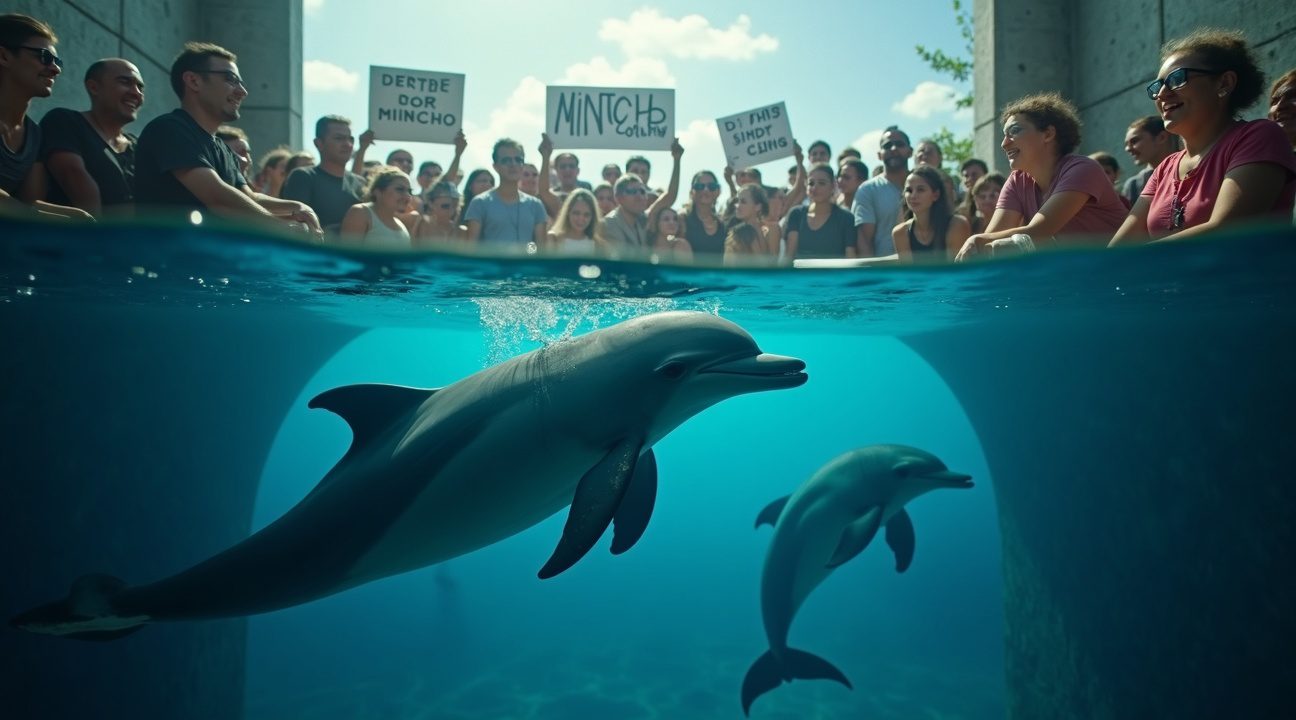
Scientific Evidence Exposes the Truth Behind Dolphin Entertainment
Years of research have dismantled the romanticized image of dolphin shows, revealing a disturbing reality behind the entertainment industry. Scientific investigations consistently demonstrate that captivity inflicts chronic stress on these marine mammals, leading to psychological trauma and physical deterioration that rarely occurs in wild populations.
Dolphins confined to artificial environments develop abnormal behaviors never observed in their natural habitats. They exhibit repetitive swimming patterns, self-inflicted injuries, and aggressive tendencies that stem from the psychological pressure of confinement. These behaviors mirror stress responses documented in other highly intelligent species when deprived of their natural environments.
Intelligence Demands Freedom
The cognitive complexity of dolphins makes their captivity particularly cruel. These animals possess advanced problem-solving abilities, self-awareness, and emotional intelligence that rivals many primates. In artificial tanks, they’re deprived of the mental stimulation essential for their psychological well-being.
Wild dolphins engage in sophisticated social structures, hunt cooperatively, and travel vast distances daily. Captive facilities can’t replicate these conditions, leaving dolphins mentally unstimulated and socially isolated. The cramped confines of performance tanks represent a fraction of their natural ranging patterns, creating an environment comparable to keeping a human in a bathroom-sized space.
Global Scientific Consensus Emerges
The scientific community has reached a clear verdict on dolphin captivity. More than 100 scientists publicly condemned the practice in 2022, citing overwhelming evidence of harm to marine mammal welfare. This unprecedented declaration reflects decades of accumulated research demonstrating the impossibility of meeting dolphins’ complex needs in artificial environments.
Disease rates in captivity far exceed those found in wild populations. Stress-related illnesses, including gastric ulcers and compromised immune systems, plague captive dolphins. The lifespan of dolphins in captivity averages significantly shorter than their wild counterparts, providing stark evidence of captivity’s detrimental effects.
Mexico’s groundbreaking legislation represents a pivotal moment in animal welfare, joining a small but growing list of nations prioritizing science over entertainment profits. Previously, only countries like India and Canada had enacted comprehensive bans on marine mammal captivity for entertainment purposes. This marine conservation milestone signals a shift in global attitudes toward wildlife exploitation.
The release of 350 dolphins demonstrates Mexico’s commitment to evidence-based policy making. Each freed dolphin represents a victory for scientific integrity over commercial interests, acknowledging that entertainment value never justifies animal suffering. This decision validates years of research documenting the psychological and physical toll of captivity on these remarkable creatures.
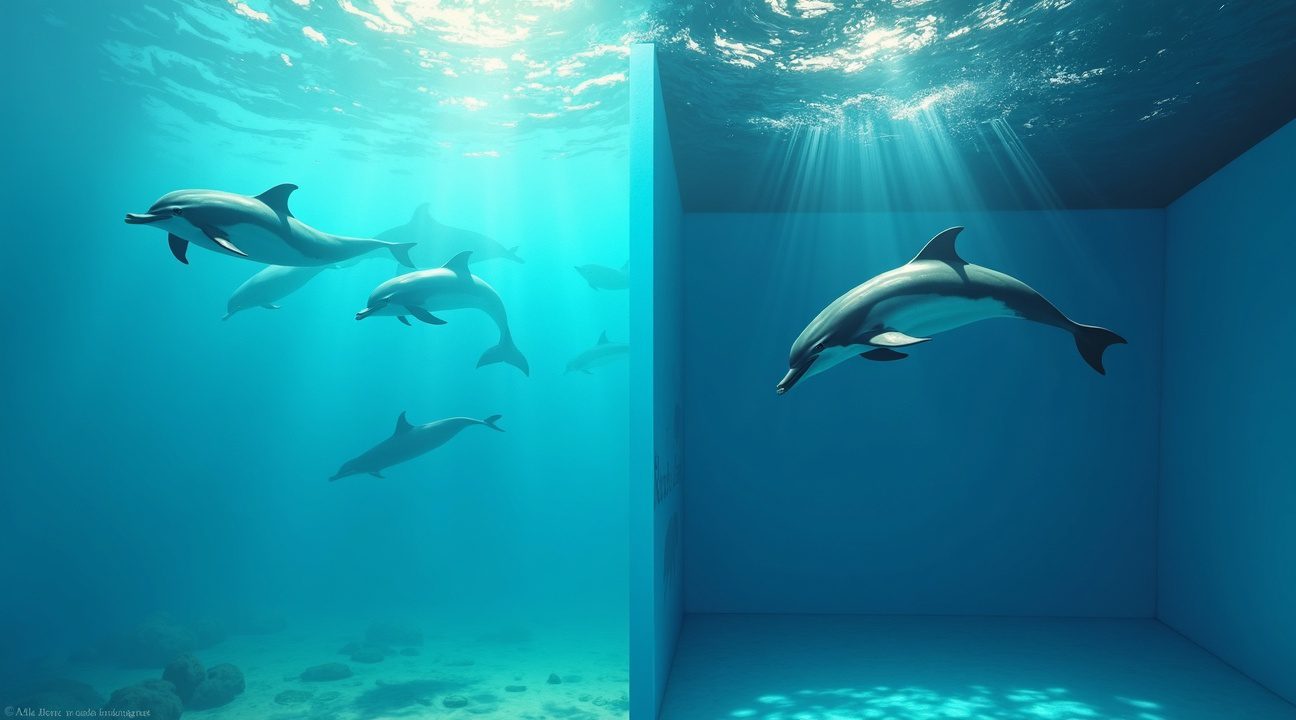
Tourism Industry Faces Major Upheaval as Dolphinariums Close
Mexico’s sweeping legislation outlawing marine mammal shows has sent shockwaves through the country’s tourism sector, forcing a complete restructuring of an industry that once generated millions in revenue. The law’s impact extends far beyond Mexico’s borders, creating precedent for international tourism policies and animal welfare standards worldwide.
Commercial Operators Struggle with Financial Devastation
The financial consequences have proven immediate and severe for major industry players. Dolphin Company (Dolphin Discovery), which operated 30 dolphinariums across Mexico, declared bankruptcy in February 2025, demonstrating the law’s transformative power over established business models. The company’s collapse illustrates how quickly the entertainment landscape has shifted away from marine mammal attractions, leaving investors and operators scrambling for alternative revenue streams.
Commercial dolphinariums now face a stark choice: transition their operations completely or cease business entirely. The prohibition on all commercial use of marine mammals leaves no middle ground for operators hoping to maintain traditional dolphin shows. However, legislators have implemented a transition period specifically designed to protect workers whose livelihoods depend on these facilities, acknowledging the human cost of this environmental policy shift.
Global Implications and Enforcement Priorities
Mexico’s decisive action has captured international attention, with tourism boards and animal welfare organizations watching closely for similar policy changes in other nations. The country’s position as a major tourist destination means this legislation will likely influence how other countries approach marine mammal entertainment within their own borders. International tour operators are already adjusting their offerings to exclude dolphin shows from Mexican vacation packages.
Enforcement mechanisms prioritize strict welfare standards and species-specific care requirements, ensuring the 350 released dolphins receive appropriate rehabilitation and monitoring. Authorities have established comprehensive oversight protocols to verify compliance with the new regulations, making clear that half-measures won’t be tolerated. These monitoring systems serve as a model for other nations considering similar legislation.
The transformation represents more than policy change – it signals a fundamental shift in how societies view marine mammal entertainment. Tourism operators worldwide are now reassessing their animal-based attractions, recognizing that public sentiment increasingly favors conservation over entertainment. Marine conservation efforts like Mexico’s dolphin release program demonstrate growing commitment to protecting ocean life rather than exploiting it for profit.
Mexico’s bold stance has effectively ended an era of marine mammal tourism, creating space for more sustainable and ethical alternatives that respect both animal welfare and economic realities.
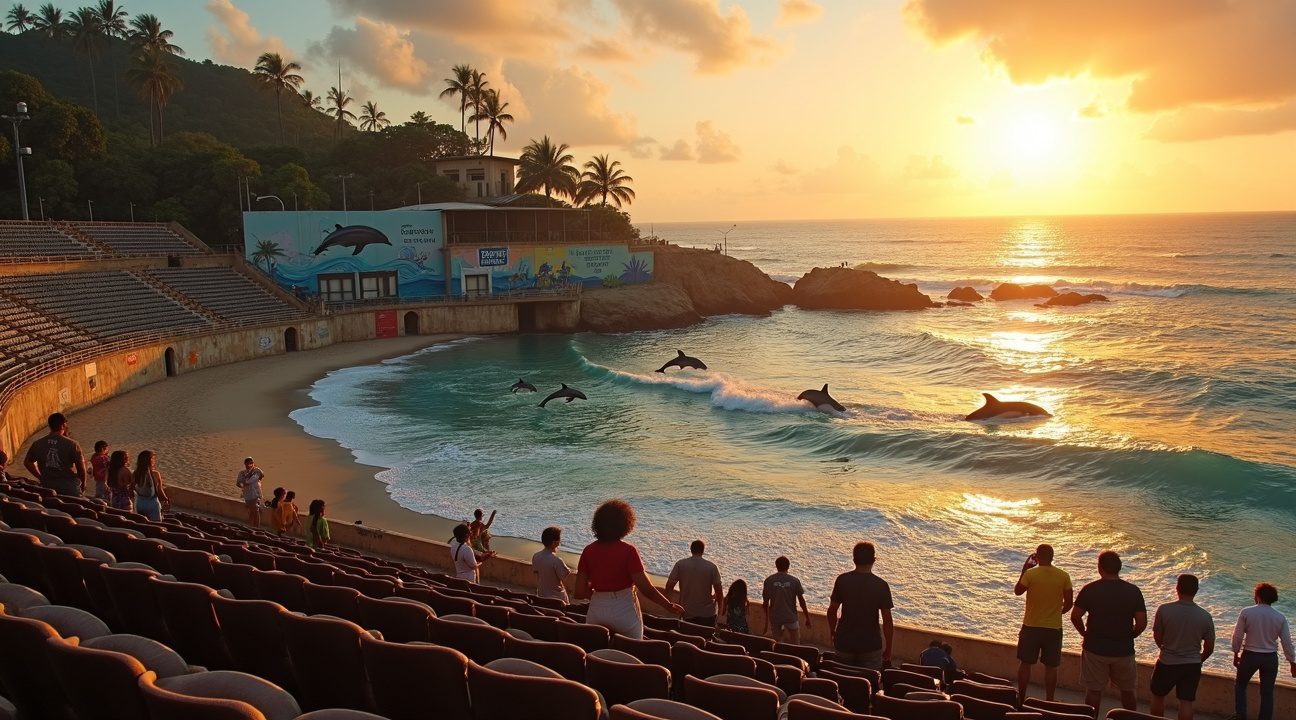
What Happens Next: Implementation and Global Impact
Mexico’s groundbreaking legislation creates a comprehensive framework for transitioning captive dolphins to more humane environments. Facilities holding these marine mammals must now construct larger, naturalistic habitats that replace the sterile concrete tanks and artificial pools that previously housed these intelligent creatures. The transition represents a significant shift from entertainment-focused environments to spaces that prioritize animal welfare and natural behaviors.
Monitoring and Accountability Measures
Animal protection organizations are pushing for several critical oversight components to ensure successful implementation:
- Mandatory regular inspections of new facilities to verify compliance with naturalistic habitat requirements
- Public reporting systems that track the health and behavioral progress of transferred dolphins
- Transparent documentation of facility upgrades and construction timelines
- Independent veterinary assessments to monitor dolphin adaptation to new environments
- Educational programs that inform visitors about marine mammal conservation rather than entertainment
Organizations emphasize that public engagement remains crucial during this transition period. Citizens can support these efforts by choosing tourism options that don’t exploit marine mammals for entertainment purposes. This consumer choice directly impacts the financial viability of facilities that rely on dolphin shows for revenue.
Mexico’s decisive action establishes a powerful precedent for international animal rights legislation. Other nations are already examining similar measures, with conservation groups using Mexico’s framework as a template for proposed legislation elsewhere. The economic transition from exploitative entertainment to sustainable eco-tourism demonstrates that animal welfare and profitable tourism can coexist effectively.
The implementation phase requires careful coordination between government agencies, facility operators, and conservation organizations. Each transferred dolphin needs individualized care plans that account for their specific health conditions, social behaviors, and adaptation requirements. Some dolphins may require extended rehabilitation periods before they can thrive in more natural environments.
International marine conservation efforts have gained momentum following Mexico’s bold stance. The legislation sends a clear message that public awareness about marine mammal intelligence and emotional capacity has reached a tipping point. Similar to how wildlife conservation efforts have succeeded in other regions, Mexico’s approach demonstrates that legislative action can create meaningful change for marine species.
Tourism operators are adapting their business models to focus on responsible wildlife observation rather than captive animal performances. This shift creates opportunities for sustainable marine tourism that benefits both local economies and conservation efforts. The long-term success of this initiative depends on continued public support and rigorous enforcement of the new regulations.
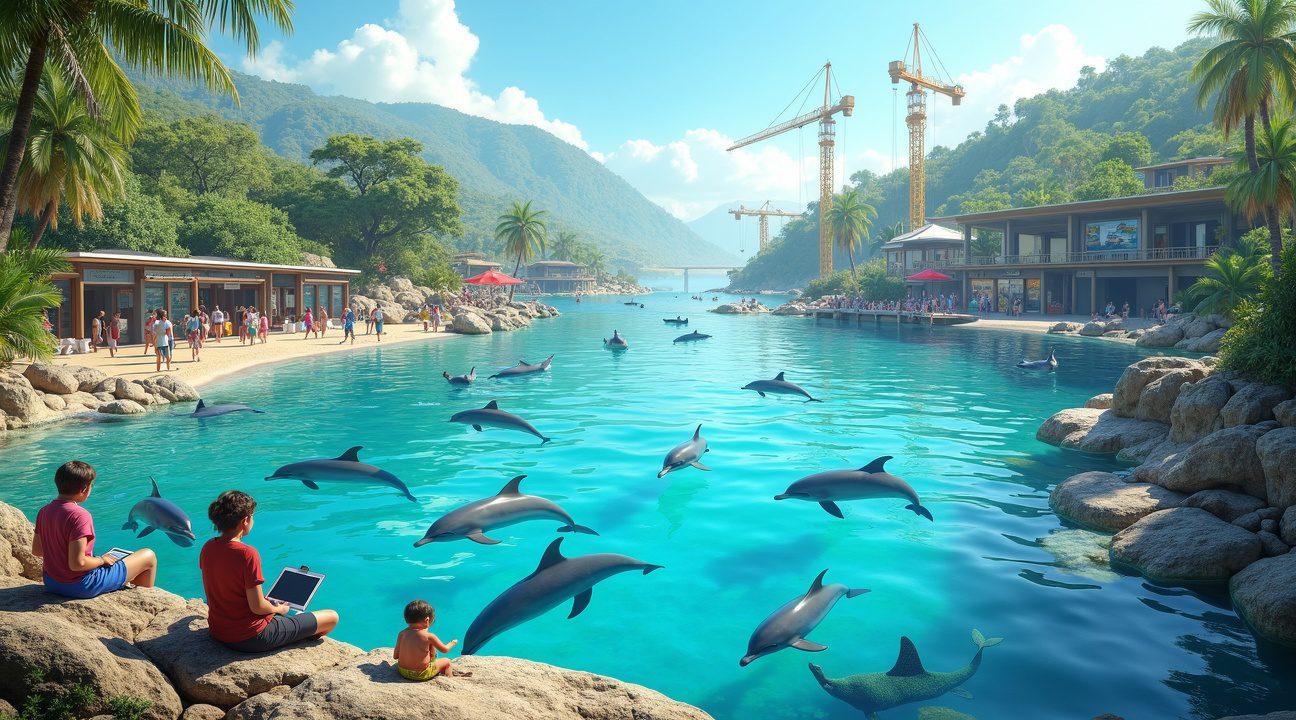
Sources:
FreeJupiter.com, “Mexico Releases 350 Dolphins Into The Wild After Banning Marine Mammal Shows”
World Animal Protection, “Mexico bans dolphin shows in historic win for animal welfare”
Yucatan Magazine, “Over 400 dolphins in Mexican tourist spots to be set free”
PETA, “Mexico Bans Dolphinariums”
Vegan FTA, “Mexico’s Congress Approves Ban on Dolphin and Whale Shows”
Riviera-Maya-News.com, “Mexico’s Senate votes in favor of new law to protect dolphins used for tourist entertainment”
Animals 24-7, “Captive dolphin industry going down, so what becomes of the dolphins?”

